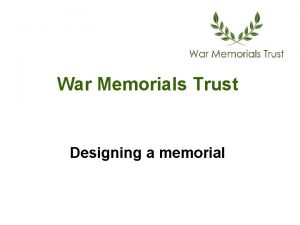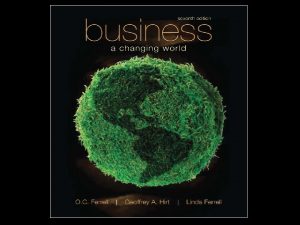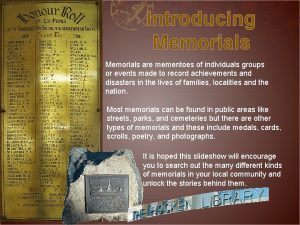Introducing Memorials are mementoes of individuals groups or













- Slides: 13

Introducing Memorials are mementoes of individuals, groups, or events, made to record achievements and disasters in the lives of families, localities and the nation. Most memorials can be found in public areas like streets, parks, and cemeteries but there are other types of memorials and these include medals, cards, scrolls, poetry, and photographs. It is hoped this slideshow will encourage you to search out the many different kinds of memorials in your local community and unlock the stories behind them.

Family Memorials Family graves provide information about the individuals , their families, lifespan, sometimes even their occupations, achievements in life, and circumstances of death. These memorials are social documents. They are primary historical sources which reveal much about the events and living conditions in the past. Collectively, family graves also provide clues about the tastes, fashion and communal values of a time now past.

Public Memorials Public memorials celebrate the lives and achievements of famous people. Public memorials also record significant events in the history of the locality or nation.

This statue in Queen’s Garden’s Dunedin commemorates Queen Victoria. She is flanked by two virtues represented by women. Justice is represented on the left and wisdom on the right. Statues 1 Statues in public places commemorate both people and events. Older statues were designed by the popular and fashionable artists of their day and reflect public taste. Students can observe • Clothing • Pose & height of statue • Other objects • Symbols associated with the person and other features such as horses, the virtues (women), flags and others. • Design features such as steps, inscriptions, religious or other symbolism.

Statues 2 This statue at Port Chalmers, Dunedin, commemorates the deaths of the members of the first British team of explorers to attempt to reach the South Pole in 1911. Scott, Wilson, Bowers Oates and Evans not only failed to to reach the South Pole first but lost their lives on the return journey. The event fired the public imagination around the Empire.

Memorial Halls Memorial halls can be found in many places. This hall in one of Dunedin’s suburban areas was built in 1911. The name of the hall is a reference to Royalty, Crown and British Empire. It was a period of belief in the greatness and power of the British Empire.

Place, Street & building names Try and uncover the names of streets and buildings in your locality that have been named in honour of a councilor, mayor, or other wellknown local individuals after their death. In some cases an individual’s achievements may be forgotten so a local history investigation could be carried out. Use newspaper reports and obituaries to find out more about your individual.

Foundation Stones & Plaques on Buildings Look out for foundation stones or plaques on buildings. Plaques are smaller and less obvious than many other memorials. They are often found on the base of buildings Blue plaques can indicate that someone important lived in a particular house. Look out for plaques that provide details of events as these can be investigated in other secondary sources.

Cairns The cairn on the right commemorates a tragic railway accident at Hyde, Central Otago, in which 21 people lost their lives. This cairn was set over the largest plot in the Tararua Acre cemetery in 1967. The Cairn commemorates the loss of 131 lives lost in the wreck of the S. S. Tararua in April 1881.

WW 1 Memorials Almost every town and village has a war memorial commemorating the dead of the two world wars. These are monuments erected by ordinary people often through public subscription in response to the huge loss of life in the First World War. These war memorials give us a feeling today of the depth of loss felt by nearly every family.

First World War Medals Commemorative war medals were presented to the next-of-kin of the men and women who served in WW 1. The medal was commonly known as the Dead Man’s Penny. The medal was presented along with an illuminated scroll and a letter from Buckingham Palace bearing the signature of King George V. Occasionally these medals were incorporated into commemorative headstones.

Stained Glass Windows Memorial stained glass window Timaru Boys’ High School. The window depicts the various armed forces of WW 2 and other symbols.

Memorial Poetry The writing of memorial poetry was very common in Victorian and Edwardian times and poems were often published in the newspapers to sympathise with those involved in a horrific event. The poem at left was published in the Daily Southern Cross by Lex to describe the tragic loss of the Townley family who were returning to the sick bed of an ailing father. Their vessel was lost at sea. Four deaths are listed on the Townley Memorial in Dunedin’s Southern Cemetery for the same day. Daily Southern Cross, Volume XIX, Issue 1998, 11 December 1863, Page 4. Papers Past. Poetry as a form of commemoration was continued into the first World War when some very famous poetry was written.
 War memorials trust
War memorials trust Antigentest åre
Antigentest åre The activities that independent individuals groups
The activities that independent individuals groups Photo/drawing of individuals/groups/institutions
Photo/drawing of individuals/groups/institutions How are ethnic groups and religious groups related
How are ethnic groups and religious groups related Soni who is dubey's daughter
Soni who is dubey's daughter A concise introduction to linguistics answer key
A concise introduction to linguistics answer key How to do quotes in mla format
How to do quotes in mla format Introducing yourself
Introducing yourself Introduce yourself interview
Introduce yourself interview Introducing flex pods
Introducing flex pods Int family
Int family Who invented the metric system
Who invented the metric system Company profile kfc
Company profile kfc

























